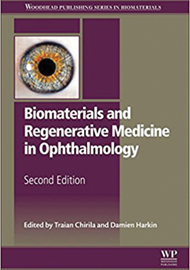With advancement in science and technology in the last decade, the role of biomaterials and regenerative medicines has become increasingly important in the management of various ocular disorders. This book highlights the role of biomaterials in the restoration of vision in sight-threatening diseases like age-related macular degeneration, ocular surface disorders, glaucoma and cataract.
This is a very comprehensive book composed of four parts including 18 chapters, covering multiple aspects of biomaterials and regenerative medicines. The introduction of the book is given in the first chapter, which gives a comprehensive account of the evolution of ophthalmic biomaterials, tissue engineering and regenerative medicines in ophthalmology. This chapter also provides a useful overview of the future trends which can help in prevention of blindness.
Part one discusses in detail the current and future challenges in the management of disorders of the ocular surface, such as dry eye syndrome, bullous keratopathy, recurrent corneal erosions, refractive surgery and corneal insult. The role and value of the biomaterial in the therapeutic practice is discussed.
The next two chapters emphasise ocular biotribology, especially coefficient friction of contact lenses and physicochemical properties of hydrogels used in ophthalmology. The most interesting chapter of part one, chapter 5, discusses the future of vitreous substitutes and biomaterials for intraocular sustained drug delivery in vitreoretinal diseases. This has huge therapeutic potential. Chapter 6 mentions the role of nonbiodegradable and biogradable devices for drug delivery, especially encapsulated cell technology and gelling agents.
Part two focuses on biomaterials for repair and regeneration of the cornea and ocular surface by using biomaterial templates and contact lens delivery of stem cells for restoration of stem cell deficiency disorders; which are caused by congenital and acquired diseases. This section also evaluates the use of silk proteins as substratum for human limbal epithelial cells.
Part three highlights applications and challenges about repair and regeneration of retina by current transplantation methods with their advantages and disadvantages in age- related macular degeneration and congenital chorioretinal disorders.
The last section discusses orbital implants, their biomaterial and paediatric considerations, and biomaterials used in glaucoma drainage devices, especially for drug delivery systems. The last section also talks about advances in intraocular lens material and long-term degradation of PMMA, silicon, hydrophilic acrylic and hydrophobic acrylic intraocular lens optics biomaterial.
The last chapter includes development and results of an artificial cornea: Alpha CorTM, includes surgical objective, procedure and complications with the help of diagrams.
This book is unique due to its subject material, as well as discussion of scientific publications in peer-reviewed journals. This makes the book successful in achieving its aims and objectives and very useful for its intended readership. This book would be helpful in the diagnosis and treatment of many unresolved ocular disorders like refractory glaucoma, ocular surface disorders and retinal diseases.
The clinical photographs and illustrations are of high quality and contribute greatly to the text, although there are minor spelling mistakes.
At £250, this book appears costly, however, given the detail of the subject matter discussed and knowledge provided, it is of great value to those practising ophthalmology. I would recommend this book to ophthalmologists, students of fellowship, undergraduates and students of optometry.




